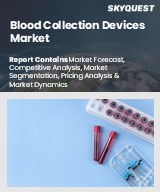
세계의 채혈 디바이스 시장 규모는 2023년에 34억 3,000만 달러로 평가되며, 2024년 37억 3,000만 달러에서 2032년에는 74억 5,000만 달러로 확대하며, 예측 기간(2025-2032년)의 CAGR은 8.7%로 성장할 전망입니다.
채혈기기 시장은 정기적인 혈액검사가 필요한 만성질환 및 감염성 질환의 유행, 수혈이 필요한 수술 및 외상 관련 응급상황 증가, 채혈 과정의 안전성과 편의성을 높이는 기술 발전 등으로 인해 강력한 성장세를 보이고 있습니다. 당뇨병, 암, 뎅기열, 말라리아 등 감염성 질환과 같이 잦은 모니터링이 필요한 질병의 발병률 증가로 인해 신뢰할 수 있는 채혈 툴에 대한 수요가 증가하고 있습니다. 안전 바늘과 자동화 장비와 같은 기술 혁신은 채혈 과정을 더욱 간소화하고 효율을 높이고 있습니다. 또한 혈장 유래 치료에 대한 수요 증가와 자발적 헌혈을 장려하는 정부의 지원책으로 인해 양질의 혈액 서비스에 대한 접근성이 확대되고 있습니다. 그러나 혈액 감염에 대한 우려, 높은 기술 비용, 시장 성장에 영향을 미칠 수 있는 규제적 장애물 등의 과제도 남아있습니다.
Global Blood Collection Devices Market size was valued at USD 3.43 Billion in 2023 and is poised to grow from USD 3.73 Billion in 2024 to USD 7.45 Billion by 2032, growing at a CAGR of 8.7% during the forecast period (2025-2032).
The blood collection devices market is experiencing robust growth, driven by an increasing prevalence of chronic and infectious diseases necessitating regular blood testing, a rise in surgical procedures and trauma-related emergencies requiring blood transfusions, and advancements in technology enhancing the safety and comfort of the blood collection process. The demand for reliable blood collection tools is amplified by the rising incidence of conditions like diabetes, cancer, and infectious diseases such as dengue and malaria, which often require frequent monitoring. Innovations, including safety needles and automated equipment, further streamline the collection process, making it more efficient. Additionally, the growing need for plasma-derived therapies and supportive government initiatives promoting voluntary blood donation are expanding access to quality blood services. However, challenges remain, including concerns over blood infections, high technology costs, and regulatory hurdles that could impact market growth.
Top-down and bottom-up approaches were used to estimate and validate the size of the Blood Collection Devices market and to estimate the size of various other dependent submarkets. The research methodology used to estimate the market size includes the following details: The key players in the market were identified through secondary research, and their market shares in the respective regions were determined through primary and secondary research. This entire procedure includes the study of the annual and financial reports of the top market players and extensive interviews for key insights from industry leaders such as CEOs, VPs, directors, and marketing executives. All percentage shares split, and breakdowns were determined using secondary sources and verified through Primary sources. All possible parameters that affect the markets covered in this research study have been accounted for, viewed in extensive detail, verified through primary research, and analyzed to get the final quantitative and qualitative data.
Global Blood Collection Devices Market Segments Analysis
The blood collection devices market is segmented by product, method, end user, and region. Based on product, the market is segmented into blood collection tubes, needles and syringes and others. Based on this method, the market is segmented into manual blood collection and automated blood collection. Based on end users, the market is segmented into hospitals and clinics, diagnostic and pathology centers, blood banks, and others. Based on region, the market is segmented into North America, Europe, Asia Pacific, Latin America and the Middle East and Africa.
Driver of the Global Blood Collection Devices Market
The rising prevalence of surgeries, trauma incidents, and blood-related health issues is driving a significant increase in the global need for transfusions. This surge in demand has heightened the necessity for effective blood collection techniques and devices. While there are extensive blood donation networks in place, the consistency and safety of the blood collected can differ markedly across various healthcare systems. As a result, the evolution of blood collection devices is crucial in ensuring that adequate supplies are available and that the highest safety standards are maintained in the collection process, ultimately enhancing patient care and outcomes.
Restraints in the Global Blood Collection Devices Market
The Global Blood Collection Devices market faces significant challenges due to the inherent risks associated with blood transfusions. Despite extensive testing and safety protocols, complications can occur, including immune responses and infections, which may lead to serious health issues. Variations between donors and recipients can result in both immediate and delayed adverse reactions, raising concerns among patients and healthcare providers alike. This uncertainty can deter potential patients from undergoing necessary procedures and poses a critical challenge for regulatory bodies focused on public health. As a result, the apprehension surrounding these clinical risks may hinder the growth and acceptance of blood collection technologies.
Market Trends of the Global Blood Collection Devices Market
The global blood collection devices market is experiencing significant expansion, driven by a surge in diagnostic testing demand attributed to the increasing prevalence of chronic and infectious diseases globally. This trend is further amplified by the necessity for regular blood testing as a crucial strategy for disease detection, management, and monitoring, particularly among the elderly and in high-incidence regions. Healthcare facilities, including hospitals, clinics, and laboratories, are progressively adopting advanced blood collection devices that prioritize precision and patient safety. This shift towards higher-end technology not only enhances diagnostic accuracy but also fosters a more efficient healthcare delivery system, reinforcing the market's growth trajectory.